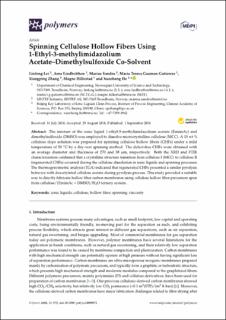| dc.contributor.author | Lei, Linfeng | |
| dc.contributor.author | Lindbråthen, Arne | |
| dc.contributor.author | Sandru, Marius | |
| dc.contributor.author | Gutierrez, Maria Teresa Guzman | |
| dc.contributor.author | Zhang, Xiangping | |
| dc.contributor.author | Hillestad, Magne | |
| dc.contributor.author | He, Xuezhong | |
| dc.date.accessioned | 2020-11-26T14:08:27Z | |
| dc.date.available | 2020-11-26T14:08:27Z | |
| dc.date.created | 2018-09-01T11:30:48Z | |
| dc.date.issued | 2018 | |
| dc.identifier.issn | 2073-4360 | |
| dc.identifier.uri | https://hdl.handle.net/11250/2689827 | |
| dc.description.abstract | The mixture of the ionic liquid 1-ethyl-3-methylimidazolium acetate (EmimAc) and dimethylsulfoxide (DMSO) was employed to dissolve microcrystalline cellulose (MCC). A 10 wt % cellulose dope solution was prepared for spinning cellulose hollow fibers (CHFs) under a mild temperature of 50 °C by a dry–wet spinning method. The defect-free CHFs were obtained with an average diameter and thickness of 270 and 38 µm, respectively. Both the XRD and FTIR characterization confirmed that a crystalline structure transition from cellulose I (MCC) to cellulose II (regenerated CHFs) occurred during the cellulose dissolution in ionic liquids and spinning processes. The thermogravimetric analysis (TGA) indicated that regenerated CHFs presented a similar pyrolysis behavior with deacetylated cellulose acetate during pyrolysis process. This study provided a suitable way to directly fabricate hollow fiber carbon membranes using cellulose hollow fiber precursors spun from cellulose/(EmimAc + DMSO)/H2O ternary system. | en_US |
| dc.language.iso | eng | en_US |
| dc.publisher | MDPI | en_US |
| dc.rights | Navngivelse 4.0 Internasjonal | * |
| dc.rights.uri | http://creativecommons.org/licenses/by/4.0/deed.no | * |
| dc.subject | viscosity | en_US |
| dc.subject | spinning | en_US |
| dc.subject | hollow fiber | en_US |
| dc.subject | cellulose | en_US |
| dc.subject | ionic liquids | en_US |
| dc.title | Spinning Cellulose Hollow Fibers Using 1-Ethyl-3-methylimidazolium Acetate–Dimethylsulfoxide Co-Solvent | en_US |
| dc.title.alternative | Spinning Cellulose Hollow Fibers Using 1-Ethyl-3-methylimidazolium Acetate–Dimethylsulfoxide Co-Solvent | en_US |
| dc.type | Peer reviewed | en_US |
| dc.type | Journal article | en_US |
| dc.description.version | publishedVersion | en_US |
| dc.rights.holder | © 2018 by the authors. Licensee MDPI, Basel, Switzerland. This article is an open access article distributed under the terms and conditions of the Creative Commons Attribution (CC BY) license (http://creativecommons.org/licenses/by/4.0/). | en_US |
| dc.source.pagenumber | 11 | en_US |
| dc.source.volume | 10 | en_US |
| dc.source.journal | Polymers | en_US |
| dc.source.issue | 9 | en_US |
| dc.identifier.doi | 10.3390/polym10090972 | |
| dc.identifier.cristin | 1605995 | |
| dc.relation.project | Norges forskningsråd: 267615 | en_US |
| dc.source.articlenumber | 972 | en_US |
| cristin.unitcode | 7401,80,1,0 | |
| cristin.unitname | Bioteknologi og nanomedisin | |
| cristin.ispublished | true | |
| cristin.fulltext | original | |
| cristin.qualitycode | 1 | |

